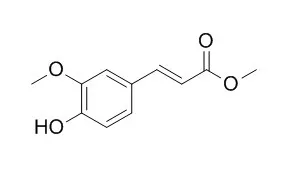| In vitro: |
| Pharm Biol. 2015 Jun 11:1-7. | | In vitro and in vivo toxicological evaluations of methyl ferulate, methyl p-coumarate, and pulegone 1,2-epoxide.[Pubmed: 26067677] | The objective of this study is to evaluate the toxicity of Methyl ferulate (MF), methyl p-coumarate (MpC), and pulegone 1,2-epoxide (PE) with in vitro and in vivo assays.
METHODS AND RESULTS:
The in vitro toxicity of Methyl ferulate, MpC, and PE was assessed at a concentration of 10 mg/ml with the Ames assay using two strains of Salmonella typhimurium TA98 and TA100. Human red blood cells (RBC) were used to determine the hemolytic activity of these compounds. PE produced 6-8% hemolysis of RBCs at all the tested concentrations while Methyl ferulate and MpC produced 10-5% hemolysis up to 20 mg/ml, and 50-85% hemolysis at concentrations of 40 and 80 mg/ml, respectively. The Ames assay indicated that Methyl ferulate, MpC, and PE were non-mutagenic as the test values were not significantly higher as compared with background values of the assay. BSLB suggested the lethal concentration (LC50) values of Methyl ferulate, MpC, and PE as 4.38, 6.74, and 25.91 mg/ml, respectively. In vivo ocular and dermal irritation scores of Methyl ferulate, MpC, and PE were comparable with ethanol (control) in rabbits indicating the non-irritant nature of these natural compounds.
CONCLUSIONS:
The present studies suggest that these compounds are non-toxic/non-irritant and might be used for medicinal purposes. | | J Ethnopharmacol. 2017 May 23;204:125-131. | | Caffeoyl and coumaroyl derivatives from Acacia cochliacantha exhibit ovicidal activity against Haemonchus contortus.[Pubmed: 28414046 ] | Acacia cochliacantha is a small tree whose foliage is traditionally used in Mexico for treatment of kidney pain, gastrointestinal illnesses and to kill intestinal parasites. In recent decades, the study of vegetal extracts has offered other possible alternatives for the control of Haemonchus contortus. Considering that this nematode affects dramatically the health and productivity of small ruminants, the aim of this study was to identify the anthelmintic compounds from A. cochliacantha hydro-alcoholic extract (HA-E) through an ovicidal test.
METHODS AND RESULTS:
In vitro egg hatch assay was conducted to determinate the anthelmintic effects of a HA-E (60g). Liquid-liquid ethyl acetate/water extraction gave two fractions (EtOAc-F, 1.92g; Aq-F; 58.1g). The less polar compounds from ethyl acetate fraction were extracted by addition of dichloromethane offering a precipitate phase (Mt-F, 1.25g) and a soluble mixture (DCMt-F 1.15g). All fractions were evaluated for ovicidal activity obtaining the egg hatching inhibition (EHI, 0.07-25mg/mL). Ivermectin (0.5mg/mL) was used as a reference drug (positive control), and distilled water, 2.5% DMSO and 2% methanol were used as negative controls. The isolated compounds from the most active fractions were subjected to spectroscopic (1H NMR) Spectrometric (MS) and UV HPLC analysis in order to identify the bioactive compounds.
The less polar treatments (AcOEt-F, DCMt-F, DCMt-P) showed the highest ovicidal activities (98-100% EHI; at 0.62-1.56mg/mL) and the major compounds found in these fractions were identified as caffeoyl and coumaroyl derivatives, including caffeic acid (1), p-coumaric acid (2), ferulic acid (3), methyl caffeate (4), methyl-p-coumarate (5), Methyl ferulate (6) and quercetin. In case of the less active fractions (Aq-F, Mt-F) were constituted principally by glycosylated flavonoids.
CONCLUSIONS:
These results show that caffeoyl and coumaroyl derivatives from Acacia cochliacantha leaves had promising anthelmintic activity against Haemonchus contortus. This leguminous may offer an alternative source for the control of gastrointestinal nematodes of small ruminants. |
|






 Cell. 2018 Jan 11;172(1-2):249-261.e12. doi: 10.1016/j.cell.2017.12.019.IF=36.216(2019)
Cell. 2018 Jan 11;172(1-2):249-261.e12. doi: 10.1016/j.cell.2017.12.019.IF=36.216(2019) Cell Metab. 2020 Mar 3;31(3):534-548.e5. doi: 10.1016/j.cmet.2020.01.002.IF=22.415(2019)
Cell Metab. 2020 Mar 3;31(3):534-548.e5. doi: 10.1016/j.cmet.2020.01.002.IF=22.415(2019) Mol Cell. 2017 Nov 16;68(4):673-685.e6. doi: 10.1016/j.molcel.2017.10.022.IF=14.548(2019)
Mol Cell. 2017 Nov 16;68(4):673-685.e6. doi: 10.1016/j.molcel.2017.10.022.IF=14.548(2019)